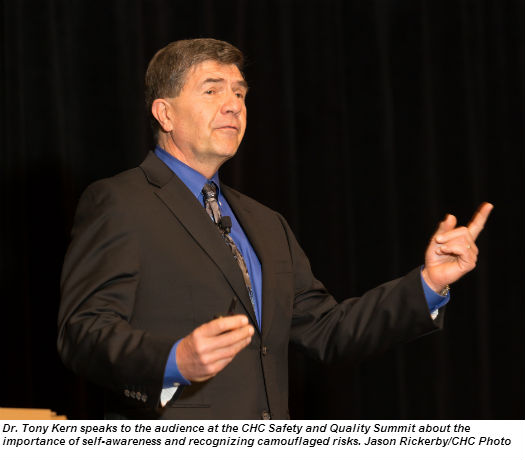
From March 31 to April 2, 2014 Vancouver played host to the annual CHC Safety and Quality Summit. This year marked the 10th anniversary of the Summit, which is hosted and organized by CHC with support and sponsorship from operators, manufacturers, underwriters and vendors.
Over 800 delegates and student volunteers from the British Columbia Institute of Technologies (BCIT) had the opportunity to participate in up to ten of more than fifty available plenary sessions. The Summit’s intimate format encouraged participants to meet, reconnect and network, while also providing opportunities to share their current challenges and ideas.
This year’s Summit opened with an address from CHC president and CEO Bill Amelio. Amelio said that within the industry there are many great safety enhancements yet to be realized and we must be “willing to challenge accepted theory.” He encouraged competitors in the audience to “knock down barriers so that we can share knowledge and effort to become better than we are today.”
Following the opening address, host Duncan Trapp, CHC’s VP of Safety and Quality, introduced the Summit’s two keynote speakers, Dr. Tony Kern and Dr. Sidney Dekker who were selected in large part for their sometimes differing perspectives.
Kern is an author, Vertical and Skies magazines contributor, and founder and CEO of Convergent Performance.
He told the audience that significant risks in the industry lay camouflaged and hidden by human ego, judgment and decision-making. To assure survival in the presence of such threats, Kern suggested the need to train better self-awareness, using a technique called “Attention Steering.” Kern explained that this approach involves “self-monitoring what you are thinking about in an effort to heighten your self-awareness and ultimately your situational awareness.”
Kern also expressed his concern about the influx of a new and relatively inexperienced generation of employees to our industry. He quoted a study completed by Boeing which estimates a demand for 498,000 new airline pilots and 556,000 engineers and technicians by 2032. In order to successfully usher in this new generation, Kern proposed that industry needs to develop and promote a strong culture of compliance. Without this, he predicted the mishap rate caused by human error to increase by 400 per cent over the next decade. He also stressed the need to apply good standards and training, strong quality assurance programs, integrated specialization and employee engagement to contribute to an active safety culture.

Dr. Sidney Dekker, a well known safety science academic and author in his first speech at the Summit aimed to challenge the community’s faith in many long held ideologies, perspectives and their resulting toolsets. He guided the audience through a historical examination of the origins of key concepts and their resulting turning points in safety science.
Dekker introduced key ideologies in safety science from the 1900s onwards, and explained their impact on reducing the incident and accident rate. Initially, the accident rate decreased markedly with each new perspective, but as Dekker approached the ideologies of the 1980s and onwards, he observed that the accident rate was remaining stubbornly high despite the best efforts of practitioners.. In fact, progress had plateaued. Therein lay the crux of his message – our current toolset is failing to reduce the remainder of the incident, injury and accident rate to near zero.
Dekker offered his insights into what could be done to help prevent future incidents, saying “rather than seeing people as the problem to control, let’s invert that thinking and see them as a resource to harness.” He encouraged organizations to hold “genuine peer reviews by those who do the dirty messy work themselves.” He suggested “keeping a discussion about risk alive even when everything looks safe,” while also encouraging leadership at all levels to create and demonstrate that everyone has a genuine capacity to say “no” without repercussions.
Click the following links to watch the speeches by Amelio, Kern, Dekker, the plenary panel discussion that included Scott Shappell, and several of the sessions for free on the Summit’s Youtube channel.

This year also welcomed a very special guest speaker at the gala dinner. Cmdr. Chris Hadfield spoke about his adventures in space travel, as well as the approaches used to develop a strong safety climate in what is arguably one of the most challenging and risky endeavors possible. Hadfield shared how a culture of preparedness, in which everyone is constantly visualizing failure and training with high fidelity training simulations, helps foster a high level of competence, empowerment and trust among teammates.
As a special gift, Hadfield offered 700 signed copies of his book, An Astronaut’s Guide to Life on Earth, and after the gala posed for photographs with nearly all attendees.
Next year’s CHC Safety & Quality Summit will be held March 23 to 25, 2015 in Vancouver. Those interested in learning more can visit: www.chcsafetyqualitysummit.com









